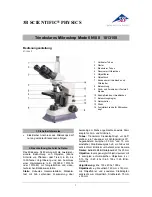
Scanning Tunneling Microscopy (STM)
STM Introduction
Rev. B
MultiMode SPM Instruction Manual
149
9.1.2 STM Hardware
Some individual STM components are described below:
STM Converter head and tipholder
—To perform STM, you need to add a MultiMode STM
convertor head (see
). The STM converter head (so-called because it “converts” the
MultiMode to a scanning tunneling microscope) consists of a rigid ring bisected by a solid support
for the tipholder. Because of the converter head’s compact construction, it holds the STM tip rigid,
minimizing vibrational noise. Mounted within the converter head is a circuit which contains the
preampli
fi
er for the tunneling current and provides interconnections to the MultiMode SPM
electronics.
Figure 9.1a
STM Converter Head
There are three types of STM converter heads available: a standard version which measures current
in the nanoampere range (Model #MMSTMC), a special, low-current version which measures
current in the picoampere range (Model #MMSTMLC), and an electrochemistry version (Model
#MMSTMEC). The low-current converter head includes an in-line electronics package.
Note:
The STM microscope heads were not designed to operate in UHV.
STM Probes
—Probes for the NanoScope STM must be 0.01" in diameter to
fi
t into the tipholder.
The two most commonly used tips are made from either a platinum iridium (PtIr, see below) alloy
or tungsten. In general, most of the discussion in this manual involving tips and noise reduction
applies to both types of tips, but there are some applications that are tip-speci
fi
c.
PtIr Probes
—PtIr probes are mechanically formed and can be purchased directly from Veeco. PtIr
probes seem to give better atomic resolution than tungsten, most likely due to the lower reactivity of
platinum. The PtIr probes are not as uniformly shaped as the tungsten tips. The quality of the
mechanically-formed PtIr probes will vary.
Tungsten Probes
—Tungsten probes are electrochemically etched from tungsten wire (see
). Tungsten probes are more uniformly shaped. They may perform
better on samples with steeply sloped features.
















































